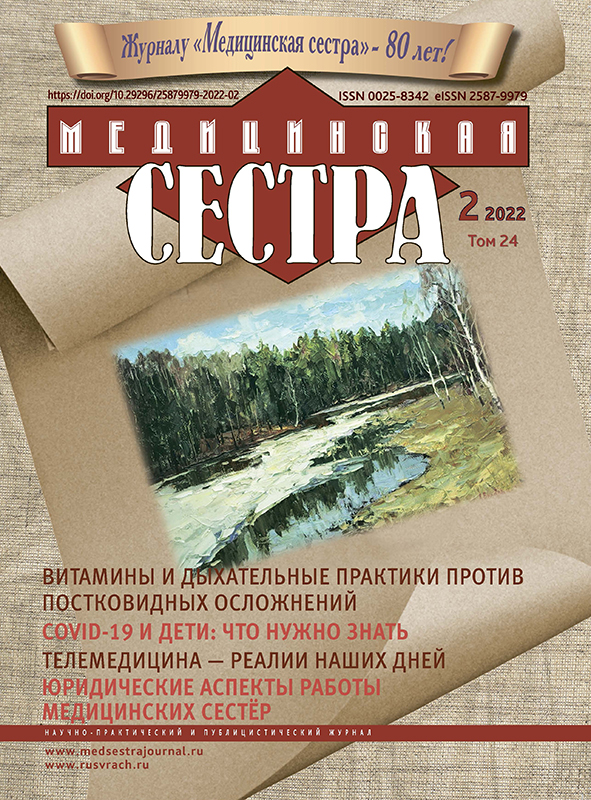Requirements for the work of middle and junior medical personnel in an infectious diseases hospital in the context of COVID-19
- 作者: Bacalin V.V.1, Odnoralov M.A.1
-
隶属关系:
- Peoples’ Friendship University of Russia
- 期: 卷 24, 编号 2 (2022)
- 页面: 23-25
- 栏目: Articles
- URL: https://journals.eco-vector.com/0025-8342/article/view/113861
- DOI: https://doi.org/10.29296/25879979-2022-02-06
- ID: 113861
如何引用文章
详细
The role of secondary and junior medical personnel is an important factor during the COVID-19 pandemic, supporting the work of health systems. Global studies on the etiology, epidemiology and pathogenesis of the new coronavirus infection have provided important information about SARS-CoV-2, including data from genetic studies that have determined the creation of effective prevention and infection control measures that should be followed by doctors, secondary and junior medical personnel. The main purpose of this work is to consolidate the lessons of the COVID-19 pandemic and to familiarize secondary and junior medical personnel with the features and rules of work during the COVID-19 pandemic, which are presented in the Resolution of the Chief State Sanitary Doctor of the Russian Federation No. 64 dated 28.11.2013 “On approval of sanitary and epidemiological rules of SP 1.3.3118-13 “Safety of work with microorganisms of pathogenicity groups I-II (danger)”, registered with the Ministry of Justice of the Russian Federation on 19.05.2014 No. 32325. These sanitary rules establish requirements for organizational, preventive measures aimed at ensuring personal and public safety, environmental protection when working with pathogenic biological agents (hereinafter referred to as PBA) of groups I - II: including when working with SARS-CoV-2 and patients with COVID-19.
全文:
作者简介
Valeria Bacalin
Peoples’ Friendship University of Russia
Email: bacalinmed@gmail.com
Department of Infectious Diseases with courses of Epidemiology and Phthisiology.
Mikhail Odnoralov
Peoples’ Friendship University of Russia
编辑信件的主要联系方式.
Email: mikalod@gmail.com
Department of Infectious Diseases with courses of Epidemiology and Phthisiology.
参考
- Кудлай Д.А., Широбоков Я.Е., Бородулина Е.А. и др. Диагностика covid-19. способы и проблемы обнаружения вируса SARS-COV-2 в условиях пандемии. Врач 2020; 31 (8): 5-10.
- Вдоушкина Е.С., Бородулина Е.А., Поваляева Л.В., и др. Сроки обращения и тяжесть состояния пациентов с поражением легких и подозрением на новую коронавирусную инфекцию при поступлении в стационар в период начала пандемии. Врач 2020; 31 (11): 60-63.
- Санитарно-эпидемиологические правила СП 1.3.311813 «Безопасность работы с микроорганизмами I-II групп патогенности (опасности)», зарегистрировано в Минюсте России 19.05.2014 №32325.
- Bartosiewicz A, Harpula K, uszczki E. The Year of the Nurse during the COVID-19 Pandemic. NursRep. 2021 Sep 29; 11(4): 753-757. doi: 10.3390/nursrep11040071.
- Профилактика инфекций и инфекционный контроль при оказании медицинской помощи пациентам с предполагаемой или подтвержденной коронавирусной инфекцией (COVID-19): временные рекомендации, 29 июня 2020 г. Женева: Всемирная организация здравоохранения; 2020 г. (https://apps.who.int/iris/bitstream/handle/10665/332879/WHO-2019-nCoV-IPC-2020.4-rus.pdf, по состоянию на 3 декабря 2020 г.).
- Уборка и дезинфекция помещений и поверхностей в контексте COVID-19: временные рекомендации, 15 мая 2020 г. Женева: Всемирная организация здравоохранения; 2020 г. (https://apps.who.int/iris/bitstream/handle/10665/332096/WHO-2019-nCoVDisinfection-2020.1-rus.pdf, по состоянию на 22 декабря 2020 г.).
- List N: disinfectants for Coronavirus (COVID-19). Источник: EPA [веб-сайт]. Washington DC: United States Environmental Protection Agency; 2020 (https://www.epa.gov/pesticide-registration/list-ndisinfectants-coronavirus-covid-19, по состоянию на 22 декабря 2020 г.).
- Трунин А.О., Чудинов И.К., Лебедева В.О. и др. Организационно-управленческие решения по борьбе с распространением covid-19 Врач. 2021; 32 (7): 5 -11.






